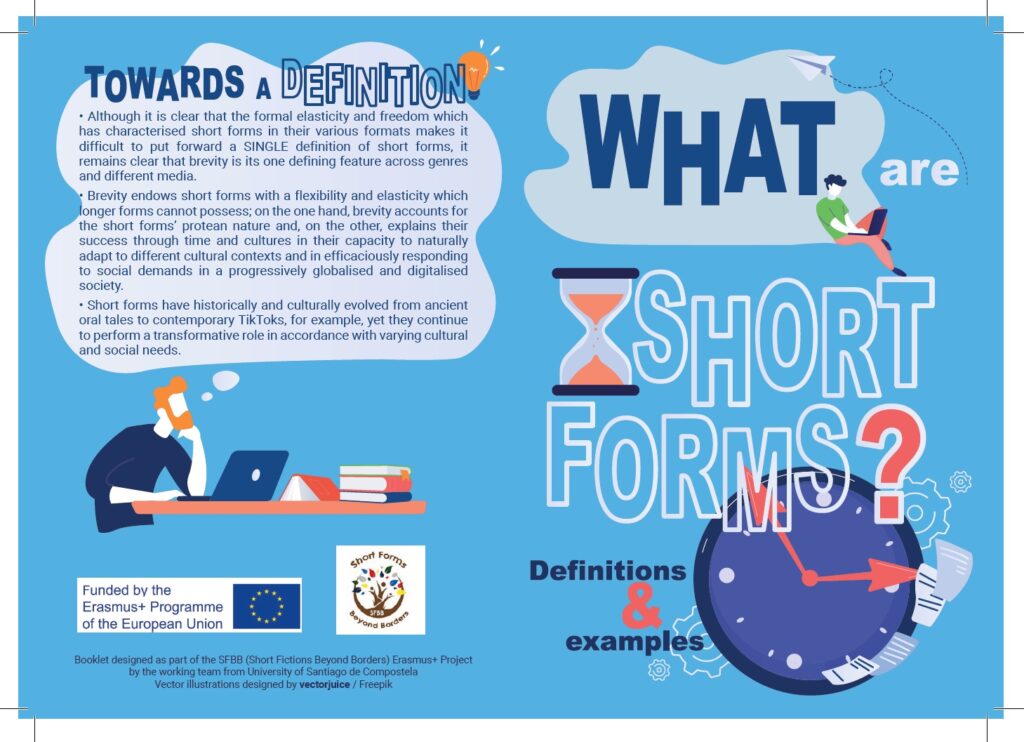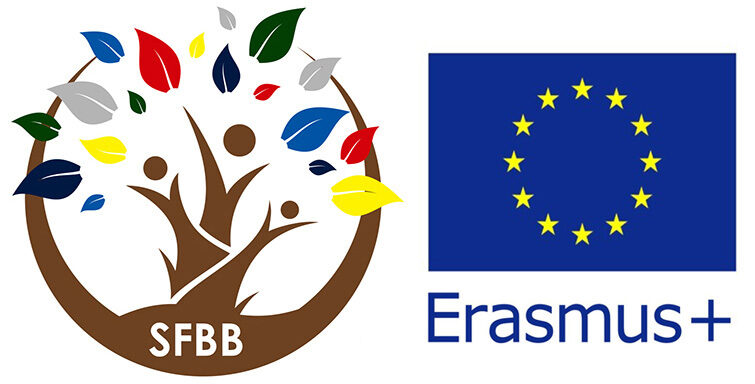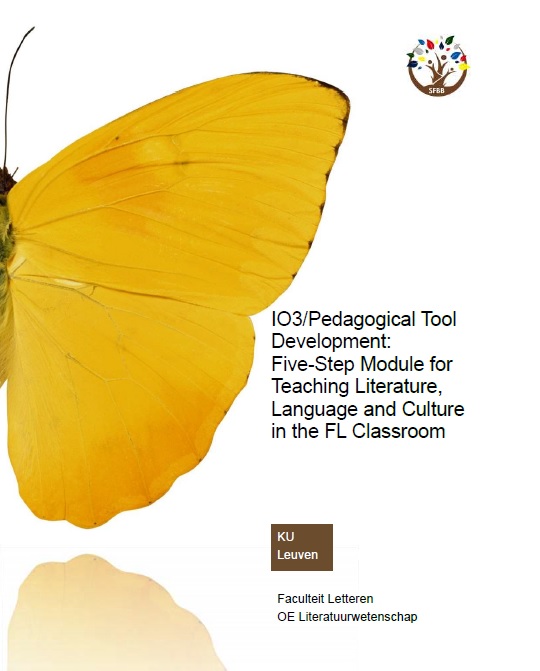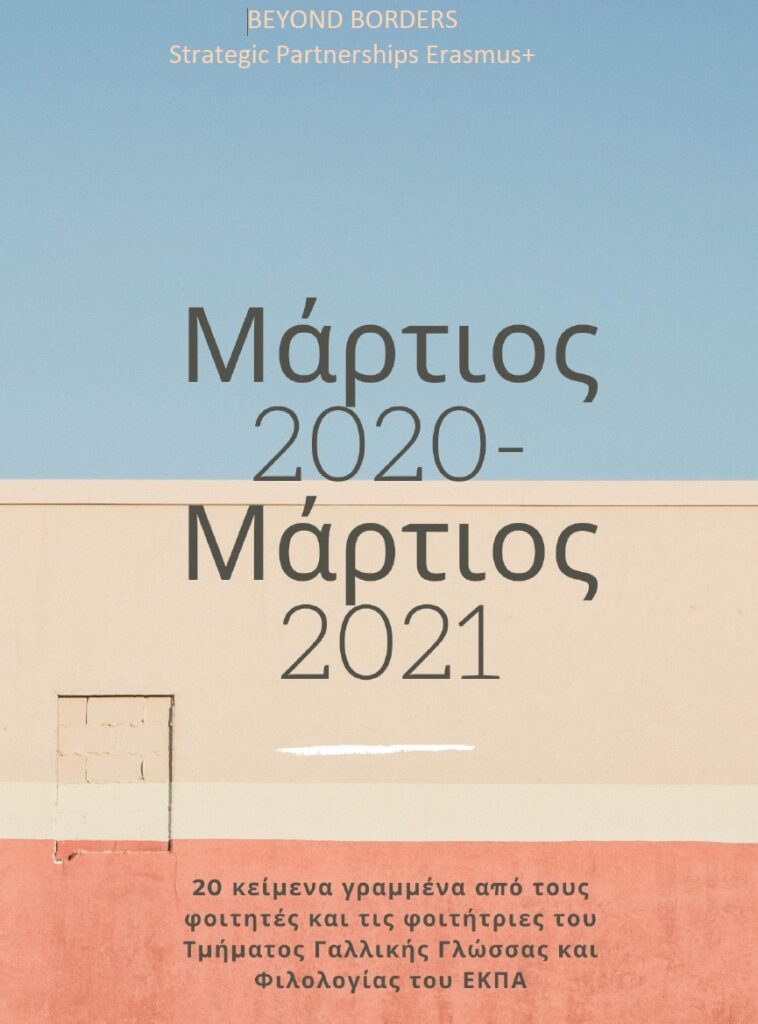THE PROJECT’S INTELLECTUAL OUTPUT STRUCTURE:
The management of the different Intellectual Outputs of the project is shared by partners:
- IO1 Definitions and surveys (dir. Angers and co.dir. Santiago)
- IO2 Digital database (dir. Szeged and co.dir. Angers)
- IO3 Pedagogical tool development (dir. Leuven and co.dir. Athens, Baludik)
- IO4 New university programmes and their guidelines (dir. Athens and co.dir. Giessen, Leuven)
These intellectual outputs are based on “training activities” for an audience of teaching professionals in higher education, and for Masters and Doctoral students.
IO1: Definitions and examples
- “What (Students and Educators) Say What Short Forms and Their Uses Are”: Click here to read presentation by the Santiago de Compostela team
- Click on the image to open and download the PDF document.

Zotero SFBB Group — a bibliography of secondary sources (in)forming the projects concept of short forms. Click HERE to view the bibliography.
IO3: Pedagogical Tool Development
- Short, but Sweet. Learning through Short Forms, Report by the University of the Leuven’s SFBB team: Click here to read the report
- Five-Step Model for teaching literature, language and culture in the FL classroom. Click HERE for more.
- 3rd Primary School pupils working on short forms. Padlet link.
- Twenty texts created by students from the Department of French Language and Literature of the National and Kapodistrian University of Athens (in Greek and French). See PDF document HERE.
- 5 steps: Le croissant du trottoir
Un mini-projet de traduction sur le texte court de Philippe Delerm, réalisé dans le cours “Syntaxe contrastive et traduction” du Département de langue et littérature françaises de l’Université d’Athènes, dans le cadre du programme Erasmus+ “Short Forms Beyond Borders” (mars 2022). Padlet link. - Following the 5-step model with Ted Hughes’s “There came a day” & Ernest Hemingway “The old man at the bridge.” Padlet link.
- 5 steps: Approaching Short Forms: how the 5-step model introduced Hemingway to a primary school class. Canva link.
- Pedagogical sheets on Michael Federspiel’novel #EntreNosMurs
- Fiche pedagogique Atelier changement temps personne EntreNosMurs: Click here to see a worksheet for EFL students on changes of tense and person using entries from a French novel.
- Fiche pedagogique Atelier doc sonore EntreNosMurs: Click here to see a worksheet for EFL students on the pronunciation of a French text based on entries in a novel.
- Fiche pedagogique Atelier écriture creative Litt1 L EntreNosMurs: Click here to discover a worksheet for EFL students on creative writing based on novel entries
- Fiche pedagogique Atelier gram et langue EntreNosMurs: Click here to see a worksheet for EFL students on working with language and grammar person using entries from a novel.
- Short reflections on short forms from the University of Giessen: Click here to access a set of short reflections on short forms produced by the teachers and students of the SFBB project during 2 virtual meetings organised by the University of Giessen in April and June 2021
- Writing poetry in the classroom: Click here to see an exercice of creative writing for L1 students in English studies (FL) using a poem by Emily Dickinson as a starting point. (by Sergio Lopez Sande)
- Reading, translating and transmediating nonsense poetry: Lewis Carroll’s “Jabberwocky”: Click here to read a lesson plan and creative exercices for the study of English nonsense poetry as a short form in the university classroom, for a BA level literature seminar session (by Anna Kérchy)
- Posthumanism in picturebooks: Creative approaches to teaching short forms of children’s literature in the university classroom: Click here to see the outline of an MA level course on “Rethinking affect and agency though human-object relations as sites for posthumanist ethics in eco-philosophical tales” (by Anna Kérchy)
- “The Old man at the bridge” : Click here for an exercise on a short story by Ernest Hemingway designed for a primary school in English foreign language (by Julie Gyftoula)
- “There came a day:” Click here for an Exercise on a Ted Hughes poem designed for a primary school in English foreign language (by Julie Gyftoula)
- Incorporating short forms into teaching practices (Comics): Click here to see task examples utilizing short form within a BA seminar course on Comics (L. Kocic-Zámbó)
IO4: New University Programmes and their guidelines
- Designing language modules on and through short forms: Click here to read a presentation by Marie-Christine Anastassiadi and Marina Vihou, National and Kapodistrian University of Athens
- Designing language modules on and through short forms in primary schools: Click here for a presentation by Julie Gyftoula
- Short forms in higher education learning and teaching: Click here to see a presentation by Michael Basseler and Kirsten von Hagen (Justus Liebig University, Giessen)
- Intermedial Innovations: Phototext (instruction in French)
- Phototext Action: Phototexts: The students of the 1st Vocational High School of Agia Paraskevi (Athens) talk about the phototext action. Google Drive link.
- Phototexts: Click on the link to watch the phototexts created by the young students of the 3rd Primary School of Zografou, Athens. Canva link.
- Phototexts created by the students of the French Language and Literature of National and Kapodistrian University of Athens. For more click HERE.
- Phototexts created and presented by the students of the 4th Primary School of Zefyri
- Baludik itineraries. Click here for a pedagogical sequence on the edutainment Baludik itineraries.
- Translations Multilingual readings15 translations of a short-form text.The original text is a chapter (day 27) of a fictional diary, written by Michael Federspiel during the first lockdown (March-April 2020) and posted day by day on his Instagram, which later was published as a book by the University of Angers.
- Mobilising Short Forms for the study of Iconic Literature: Pedagogical sequence and sample lesson plan
Colleagues from the University of Angers (Colette Colligan, Etienne Garnier and Michelle Ryan) developed a pedagogical sequence based on Leuven’s model for deep reading. The university of Angers pairs two courses to reach the objectives of the Leuven Model. One course foster deep reading and the second course mobilises short forms to foster student engagement and curiosity to study iconic works of British literature. To learn more about the course sequence on iconic British literature, click HERE. - Pedagogical sequence on Michael Federspiel’s Instagram novel #EntreNosMurs
- Click here to access a lesson sequence for EFL students based on entries in the Instagram novel #EntreNosMurs by Michael Federspiel
- “Parcours pédagogique Athènes EntreNosMurs trouver son match” : Click here to see a pedagogical sequence developed by the Athens team
- Click here for an activity sheet designed for the Insta novel #EntreNosMurs
- Click here for interview with Michael Federspiel, the author of #EntreNosMurs
- Formes Breves M2 didactique des langues, Enseignants de Langues en Europe (ELE) franco-hellénique: Master FLE: Click here to access a lesson sequence for EFL Master students on short forms
- Coun-ting Down: Song-writing Seminar in Athens: During the Athens Meeting in May 2023, Michael Federspiel and Shannon Tibbs (University of Angers) proposed an original teaching sequence. After reflecting on the history of the folk song and studying its structure and themes, the students had to draft a song, respecting the constraints of this musical genre and prosody. The best text was set to music by the teachers, and from this result, the students had to write a storyboard. Click here to see the instructions and the storyboard, click here to see the chords and lyrics of the song Coun-ting Down, and click here to listen the song produced by the students and set to music by the teachers.
- Booktubes videos on classical short stories (Cécile Meynard, professor in French literature)Within the frame of a lesson on « short forms » with Master 2 students, from different disciplines in literature and languages (French literature, English studies, Hispanic studies, Germanic studies…), students were asked to present short videos (3mn max) on the model of Booktube videos but on classic short stories, rather than on trendy books (romance, fantasy, thriller…) as booktubers usually do… Click here for details
- Click here to discover a Booktube-style presentation of a short story by Jackie Kay, “Mind the Way”
- Click here to discover a Booktube-style presentation of a short story by Oe, “Seventeen”
- Click here to discover a Booktube-style presentation of a short story by Claire Keegan, “Antarctica”
- Lesson plans for short texts by Ted Hughes and Ernest Hemingway: Click here to read a Lesson plan in 5 steps for a primary school in English foreign language


